Text and Photos By Jeffrey A. Rendall
BLUFFTON, SC -- If you think about it, golf courses are really like gourmet recipes - they require mixing several different elements to become 'whole.' Similarly, when you're preparing your favorite meal, you might take a pound of something, mix in a half-cup of something else, add three or four pinches of spice and bake for an hour and a half. If you've cooked the dish enough times, you probably won't even need to dig the recipe out of the drawer the next time. It's locked in your head.
A golf course also has 'ingredients' - grass, sand, water - and depending on the location, maybe wetlands, rock cliffs, desert scrub, sand dunes or elevation changes. There're also some intangibles, such as site location and ownership. Like food, when you're building a golf course, you've got to 'cook' it right the first time, or it'll spoil easily.
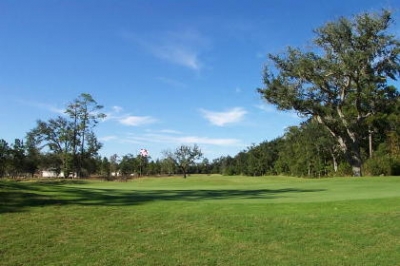 |
| Large oak trees define Eagle's Pointe's 9th hole. |
And sometimes, despite the best of building blocks, the product doesn't always turn out the way you planned it - just as not all cooking recipes are foolproof. You can still burn a perfect roast if you don't check its temperature - or you can make some awful gooey waffles if the batter's not just right.
It's a good thing the folks who build golf courses know what they're doing - they take just about any quality of ingredients, mix in some philosophies, add some hard work, and come out with a finished product that people will like and enjoy - and perhaps more importantly, want to come back and play again.
Eagle's Pointe Golf Club in Bluffton's (South Carolina, near Hilton Head) a good example of how not every golf course conforms to the standard building model - yet comes together at the end to present an edible delight for everyone who wants to sample it. And in this case, a good portion of the credit for the finished product goes to its course designer, Davis Love III.
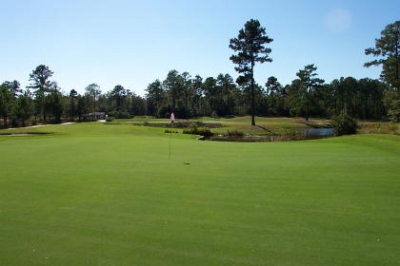 |
| The 8th hole is an attractive par three. If the pin's up front, it will be a tough choice of clubs off the tee. |
Love's designer partner, brother, and sometimes caddy, Mark Love, said he's happy the Eagle's Pointe product turned out so well, because there were some problems in building it - the ingredients didn't gel at first: "Eagle's Pointe was our third project, and I'd have to say it was the most difficult thus far (they've done nine to date), for a couple reasons. First, the soils on the site were simply awful - just a mucky quagmire, not really suitable for anything associated with a golf course."
Love continues, "Then we had some disagreements amongst the original ownership group, which led to construction being completely halted for about three months. The current group then came in and finished off the course - and I'll add, did an excellent job. It's a good thing we'd been able to complete most of the design work before the troubles started, and we're extremely pleased with the way everything turned out. We continue to receive very encouraging feedback from Eagle's Pointe."
Part of that positive feedback stems from the course's playability. Brent Carlson, Head Golf Professional at Eagle's Pointe, says the course differs from a lot of its peers in the area because it's friendlier to the average player: "Too many times on this island we see plenty of people that 'play above their heads,' meaning they'll move back to the gold tees with a 20 handicap and have a miserable time."
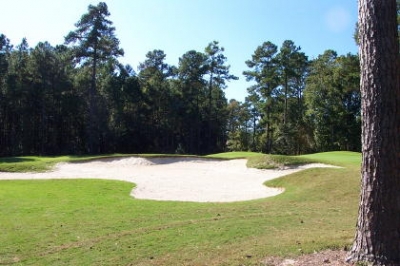 |
| This huge sand bunker protects the green on the 6th hole. It's a short par 4, but short doesn't always mean it's easy. |
"You can almost do that here and not be miserable, even if you're the average player. I think the length from the tips would get you, but there isn't trouble lurking around every turn like there is at some others - which for your better players, is a desired quality. But not for 90% of the people that play golf here, which is kind of nice," Carlson adds.
I'd have to say Carlson's right. Eagle's Pointe is very friendly to the average player, mostly from the fact the trouble is to the sides instead of right in front of you. A straight hitter will do well here (as is true at most courses), and most of the time you won't have to worry about penalty strokes if a shot's a tad short or long.
There are very few forced carries - only two I'd label as difficult, on numbers seven and eleven - and those are approach shots, most likely with short irons. There's never been a friendlier course to the worm-burner off the tee. Low-ball hitters are most welcome here.
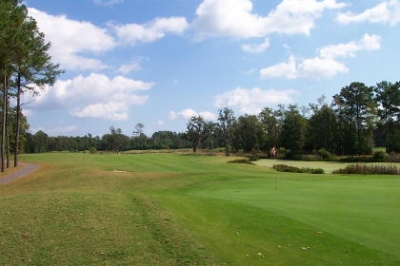 |
| Stay to the right off the tee of the 17th hole. Wetlands and marsh protect the length of the hole on the left. |
Where Eagle's Pointe's challenge lies is in the greens. They're huge. Carlson describes it this way: "Most courses around here are known for certain things, like Harbour Town's famous for small greens. We're known for just the opposite - our greens are huge, which presents a different type of problem for players. At both courses you'll need to be precise with your iron play to leave some short putts. Here, the average player will hit many more greens - but have a more difficult time getting down in two."
Mark Love says that's part of their design philosophy - to leave a lot of room for average players to drive the ball, but challenge better players around the greens. And unlike their firm's first project on Fripp Island (Ocean Creek, where there're quite a few carries over wetlands and water), they were able to accomplish this at Eagle's Pointe. "The comment we hear most about Eagle's Pointe is that it's a fun golf course. There's some challenge there - with the wetlands and water in places, but generally it won't be hard on average players. We really like the greens complexes there. We tried to match the greens with the type of shot that's played into it - I think it worked extremely well."
Also noteworthy at Eagle's Pointe is the service. Carlson elaborates on their philosophy: "The reason we're here in the first place is to make sure people have a great time. We certainly try to affect the things we can control, such as staff attitude and maintenance - we try to run a tight ship. We want people to have an enjoyable golf experience. Your golfing day out here can be as great or as terrible as you make it. But we want to give you the opportunity to make it great."
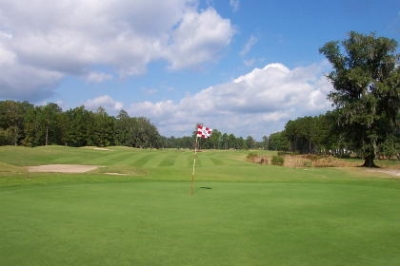 |
| Eagle's Pointe's 4th hole is a difficult par for just about everyone--because it plays longer than its 445 yards. |
The fun starts at number one, which oddly enough, requires a carry off the tee - but a mild one at that. 401 yards and slightly downhill, there's plenty of room in the fairway - but some strategically placed oak trees could block your view of the green if you flirt with the fringes.
Four's a tough par four, 445 yards and plays much longer. Carlson says: "For some reason, if we get any rain at all, number four has a tough time drying out - which tends to take most of the roll out of your drive." That essentially leaves a fairway wood into the green for most of us. Needless to say, par's a good score here.
Six is a terrific short par four. Mark Love commented, "If the land will yield it, we definitely like to work in things such as a drivable par four, or some risk-reward type par fives. We feel these 'standard' features on a golf course give it character - and that's what we're looking for." Well, this hole definitely has character. 329 yards from the tips, it's not really 'reachable' for anyone but Davis and his fellow touring pros, but the hole still invites you to take out the big stick and have a go at it. Fun hole.
 |
| The 10th hole is a challenging but fair par five. A true three-shotter, keep the ball to the right on the hole, or you'll certainly get wet. |
Nine's the #1 handicap link, and probably also takes honors as most intimidating tee shot. There's water all down the right side, and a large oak tree rests comfortably to the right-center of the fairway - leaving sort of a split-fairway. There's another huge oak tree to the left side of the green, which happens to be well guarded by bunkers on each side, too. If this hole had a name, it'd be 'Oak Trees.'
I'll let Carlson describe ten. "From a design standpoint, I really think ten's a great three-shot par five. You'll need accuracy off the tee, then a metal wood or longer iron to a relatively flat lay-up area, and the third shot's to a challenging green suitable for a par five. It's not so severe that if you miss your second shot to the right that you end up dead - and that's the way it should be. A very fair golf hole, and well laid out." You will have to avoid the water right on the tee shot, then left on the second, but all in all, a fair test.
Eleven brings in the area's natural wetlands look - 159 yards with a full carry from the back tees. Standing on the tee, it looks a lot longer than that - but that's the beauty of a hole like this - it looks harder than it plays. This is probably the hole you'll remember most from Eagle's Pointe, hopefully because you score well here.
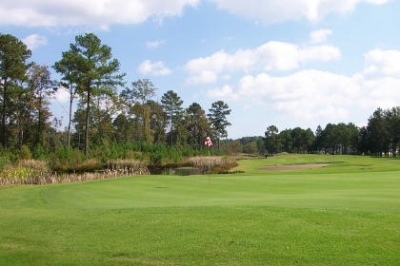 |
| Marsh and water protect the 15th hole's right side, bunkers guard front and long, and the green is challenging. A fun par 3. |
Fifteen's the longest par three on the course at 206 yards, but once again presents fair challenge. There's water to the right, a bunker short, and pot bunkers long - with some bailout room to the short left. This green's a good example of how you'll need to hit it close to have a birdie try - or even a potentially difficult shot at par.
The round closes with a medium length par four, 392 yards, straight as an arrow, and a very tricky green with a rise in the middle - lower on the front and backsides. One more tough putting challenge awaits.
It's fitting the closing hole at Eagle's Pointe presents a straightforward, fair challenge. There's nothing hidden about it - which is pretty much true of the entire golf course. Eagle's Pointe's playability is probably the reason it's a local favorite - but if I had to guess why, I'd say it's because the course blends together all the right ingredients. To sum up, it's prepared scrumptiously!
Details:
Eagle's Pointe Golf Club
1 Eagle's
Phone: (888) 325-1833; (843) 686-4457
FAX: (843) 706-2610
Website: www.eaglespointegolf.com
Course Architects:
Head Golf Professional: Brent Carlson
|
|
Yardage/Slope |
Rating |
|
Love III |
6782/130 |
73.1 |
|
Blue |
6399/126 |
71.8 |
|
White |
6026/117 |
69.6 |
|
Red |
5210/119 |
67.2 |
Rates: (Seven Days A Week)
Summer/Winter: $53
Fall: $65
Spring: $86
Packages available with sister course Crescent Pointe, $109-$189 to play both.
| Related Links | Comments on this article? | |
|
Maryland National Golf Club Hollow Creek Golf Club Rocky Gap Resort PB Dye Golf Club in Ijamsville Whiskey Creek Golf Club |
E-mail Jeff Rendall, Editor: jrendall@golftheunitedstates.com |












